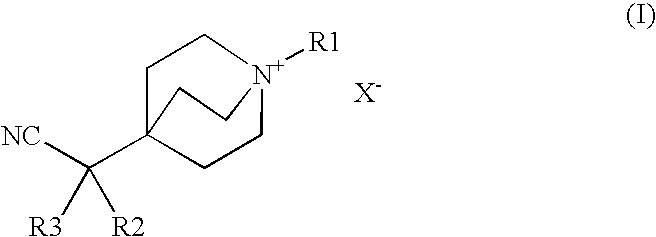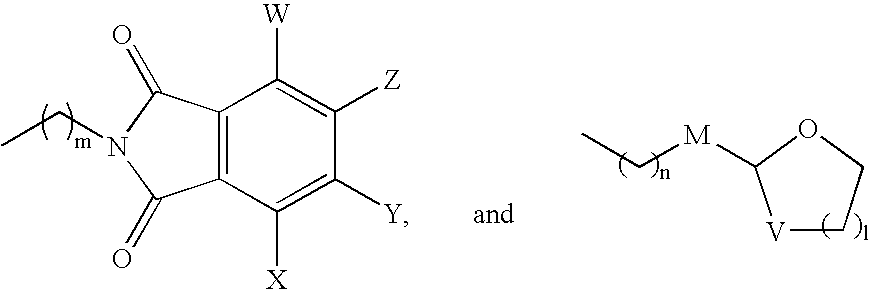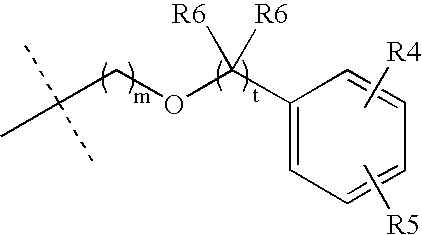Muscarinic acetylcholine receptor antagonists
a technology of acetylcholine receptor and muscarinic acetylcholine, which is applied in the field ofquinuclidines derivatives, can solve the problems of airway hyperreactivity and hyperresponsiveness, relatively few anti-cholinergic compounds are available for use in the clinic, and the product is currently not available in the united states
- Summary
- Abstract
- Description
- Claims
- Application Information
AI Technical Summary
Benefits of technology
Problems solved by technology
Method used
Image
Examples
example 1
Preparation of 1-azabicyclo[2.2.2]oct-4-yl(diphenyl)acetonitrile
Ethyl 1-(2-chloroethyl)-4-piperidinecarboxylate
[0085] To a solution of ethyl nipecotate (20.0 mL, 130 mmol) in acetone (180 mL) was added 1-bromo-2-chloroethane (21.6 mL, 260 mmol) followed by anhydrous K2CO3 (27.12 g, 196 mmol). The reaction mixture was stirred for 24 h and then concentrated under vacuum. The resulting residue was treated with H2O (75 mL) and extracted with Et2O. The combined organic layers were dried over MgSO4, filtered, and concentrated under vacuum. Purification of the crude residue by flash chromatography (50% Et2O / 50% hexane) on silica gel gave the title compound (10.99 g, 38.6%). EI-MS m / z 220(M+H+) Rt (1.20 min).
Ethyl 1-azabicyclo[2.2.2]octane-4-carboxylate
[0086] A solution of ethyl 1-(2-chloroethyl)-4-piperidinecarboxylate (20.42 g, 92.9 mmol) in THF (600 mL) was cooled to −50° C. under Ar. LDA (2.0 M in heptane / THF / ethyl benzene, 70 mL, 140 mmol) was slowly added to the solution at −50°...
example 2
Preparation of 4-[cyano(diphenyl)methyl]-1-[3-(phenyloxy)propyl]-1-azoniabicyclo[2.2.2]octane bromide
General Procedure for Salt Formation Without HPLC Purification
[0089] To a solution of 1-azabicyclo[2.2.2]oct-4-yl(diphenyl)acetonitrile (0.1468 g, 0.485 mmol) in 2CH3CN / 3CHCl3 (10 mL) was added 3-bromopropyl phenyl ether (0.10 mL, 0.634 mmol). The solution was heated to 60° C. for 16 hours. The reaction was cooled to room temperature and concentrated under vacuum. The residue was taken up in ethyl acetate and hexane causing a solid to crash out of solution. This solid was filtered off, and washed with hexane to give the title compound (0.1986 g, 79.4%). EI-MS m / z 437(M+) Rt (2.17 min).
example 3
Preparation of 4-[cyano(diphenyl)methyl]-1-[2-(phenyloxy)ethyl]-1-azoniabicyclo[2.2.2]octane bromide
[0090] Following the general procedure outlined in Example 2, 1-azabicyclo[2.2.2]oct-4-yl(diphenyl)acetonitrile (0.0499 g, 0.165 mmol) and 2-bromoethyl phenyl ether (0.0760 g, 0.378 mmol) in 2CH3CN / 3CHCl3 (4.0 mL) were reacted to give the desired product (0.0548 g, 66.0%). EI-MS m / z 423(M+) Rt (2.20 min).
PUM
| Property | Measurement | Unit |
|---|---|---|
| temperature | aaaaa | aaaaa |
| temperature | aaaaa | aaaaa |
| temperature | aaaaa | aaaaa |
Abstract
Description
Claims
Application Information
 Login to View More
Login to View More - R&D
- Intellectual Property
- Life Sciences
- Materials
- Tech Scout
- Unparalleled Data Quality
- Higher Quality Content
- 60% Fewer Hallucinations
Browse by: Latest US Patents, China's latest patents, Technical Efficacy Thesaurus, Application Domain, Technology Topic, Popular Technical Reports.
© 2025 PatSnap. All rights reserved.Legal|Privacy policy|Modern Slavery Act Transparency Statement|Sitemap|About US| Contact US: help@patsnap.com



